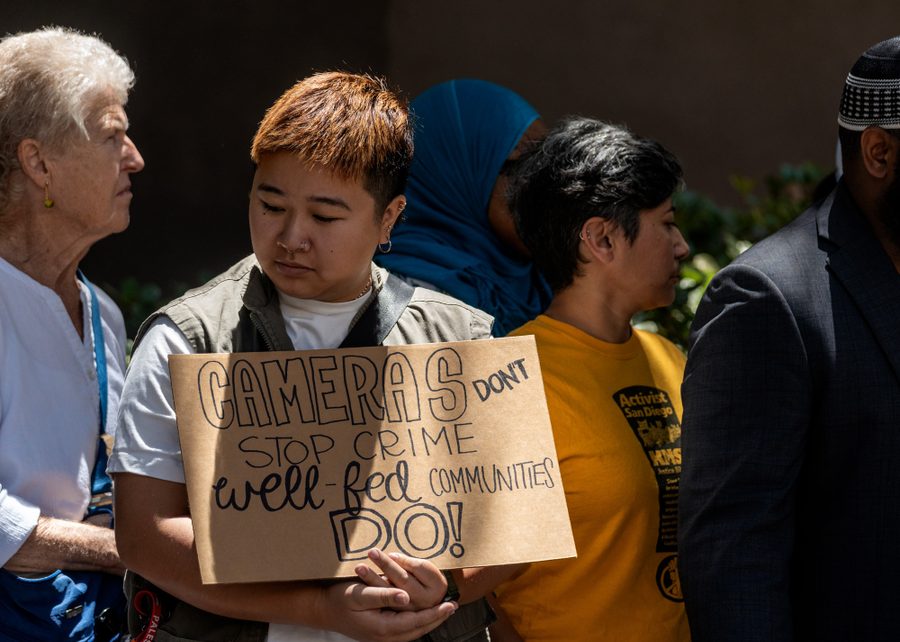How San Diego Built a Surveillance Apparatus Under the Guise of “Sustainability”
What started as a green infrastructure project quickly spiraled into a crisis of mass surveillance.
Jesse Marx

SAN DIEGO, CALIF. — It sounded smart on paper. In 2016, the San Diego City Council created a new infrastructure project related to its environmental initiatives: Thousands of streetlights would be retrofitted with energy-efficient LEDs. Plus, remote-controlled sensors would produce publicly accessible data on weather, traffic and parking. Considering the energy savings, the $30 million partnership with General Electric would pay for itself. Win-win.
But today, the project is an example of how not to create “smart” city utilities.
Those sensors included integrated cameras, and no councilmember formally opposed the potential surveillance issues. Most San Diego residents only learned they were filmed indiscriminately thanks to media reports — in 2019.
As activist jean-huy tran said at a public safety meeting on Jan. 29, 2020, “It caught everyone completely by surprise.”
A steady drip of revelations followed: The technology was originally housed under San Diego’s Sustainability and Mobility Department, but the city never produced the promised public data. The city also gave the police department exclusive access to the cameras. The system’s maintenance cost well exceeded the projected energy savings. And hundreds of the cameras were purchased with federal anti-poverty dollars.
Dozens of community groups, representing some of the city’s most vulnerable residents, united under the banner of the TRUST SD Coalition to warn about how the technology could undermine civil liberties— disproportionately harming Black and brown residents through increased policing.
“We must not allow these harms to mature and metastasize,” reads one coalition post.
“We must not allow these harms to mature and metastasize,” reads one coalition post.
These fears culminated in summer 2020. Despite assurances that the city would only use the tech to prosecute serious offenses, police tapped into the network to investigate protesters at Black Lives Matter demonstrations.
Community groups and some elected officials demanded an end to the program.
The city council soon blocked further funding, and Mayor Kevin Faulconer ordered his staff to shut the network down— but they couldn’t. Turning the devices off wasn’t as simple as flipping a switch. General Electric had sold the technology to a venture capital-fueled “smart infrastructure” company called Ubicquia in Florida.
At one point, Ubicquia CEO Ian Aaron offered to keep providing the police department’s access to the cameras for free even after the devices stopped collecting environmental and traffic data as requested.
“Clearly these are unprecedented times for law enforcement,” he said in an email weeks after the police murder of George Floyd.
The mayor accepted this offer. But after more intense pushback from activists and some councilmembers, the mayor asked Aaron to end the entire operation, including the police department’s access to camera footage.
“If you want us to create a software switch,” Aaron wrote in response to this directive, “we can write custom code and deploy it. The units were not designed for this originally.” Later, in an email, Aaron told officials in the sustainability department that he’d be happy to fulfill their request as soon as the city paid for prior work.
Ultimately, the internet connection to the streetlights and sensors was severed — but the cameras kept rolling, because they were still powered on. Police and prosecutors continued to access the devices with warrants, provided they could still download the footage manually (without an internet connection) before it automatically deleted itself every five days.
Without regular maintenance, the devices drifted into disrepair and no longer worked, according to the police department.
“There is no denying the benefit and crucial role these tools can play in solving crimes,” Councilwoman Monica Montgomery Steppe said on Jan. 29, 2020. “However, allowing surveillance technology to show up in our neighborhoods unannounced and uncontrolled will further erode trust.”
As chair of the Public Safety and Livable Neighborhoods Committee, Montgomery Steppe joined TRUST SD to create new transparency rules, which led to the creation of an official privacy advisory board made up of volunteers. Rather than ban surveillance devices outright, the city agreed that outside experts— in areas such as law, computer science and civil rights — should vet technology before its purchase and deployment.
The new rules were put to the test this summer after the San Diego Police Department proposed bringing the streetlight surveillance system back — this time, pairing hundreds of cameras with automatic license plate readers, an unprecedented project in the United States. The city’s appointed privacy experts objected on the grounds that the police failed to provide enough information (about vendors, program design, AI-enabled technology, security safeguards and potential alternatives) to properly vet the proposal. Ubicquia was again listed as a partner.
The head of the San Diego police union framed the proposal in simple terms — “a vote for public safety” versus a vote “to embolden criminals.” But research compiled by the ACLU and academics suggests that while cameras may reduce property crime, they don’t deter violent crime. In an era of extreme income inequality, then, a question arises about whether surveillance should be a financial priority.
“Law enforcement wants to monitor crime at taxpayers’ expense instead of investing in preventative measures to stop crime before it even happens,” says Michael Whyte Jr., a member of the nonprofit Pillars of the Community.
Though police officials argue that the criticisms of streetlight surveillance are speculative, they’ve conceded that the data could fall into the wrong hands.
They’ve promised to exclude certain federal agencies from accessing license plate information in shared law enforcement databases. The department also claims it won’t tap into the cameras in real time and won’t deploy facial recognition features. The footage will also be overwritten every 15 days, unless downloaded as part of an investigation; license plate data will be deleted every 30 days.
San Diego’s elected leaders ultimately decided the proposed internal procedures were sufficient guardrails against abuse— effectively authorizing the use of a new surveillance system— but the city council vote was not unanimous. Council President Sean Elo-Rivera, one of two who objected to the cameras and one of three who objected to the license plate readers, told colleagues at an August 1 meeting that he wasn’t confident the police technology would be in good hands. “There’s too many unanswered questions,” he said.
Activists will get another chance to interrogate the new surveillance proposal as soon as the police department gets around to producing contracts for city council’s final consideration.






